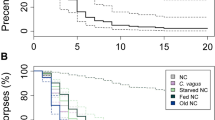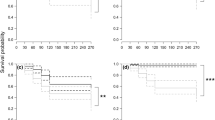Abstract
This study was conducted on the reactions of Pheidole megacephala scouts when finding liquid food sources situated on territories marked by competing dominant ant species or on unmarked, control areas to see if the number of recruited nestmates is affected and if soldiers behave in ways adapted to the situation. We show that scouts recruit more nestmates, particularly soldiers, on marked rather than on unmarked areas. This recruitment allows P. megacephala to organize the defence and rapid depletion of these food sources prior to any contact with competitors. Soldiers can carry liquid foods both (1) in their crops like other Myrmicinae and (2), in a new finding concerning myrmicine ants, under their heads and thoraxes like certain poneromorph genera because the droplets adhere through surface tension strengths. Later, the liquids stored in the crop are distributed to nestmates through regurgitations during trophallaxis and the external droplets are distributed through “social buckets”, or the mode of liquid food transfer common in poneromorphs. Their flexibility to use or not use the latter technique, based on the situation, corroborates other reports that Pheidole soldiers have a relatively large behavioral repertoire.


Similar content being viewed by others
References
Beugnon G, Dejean A (1992) Adaptive properties of the chemical trail system of the African weaver ant. Insect Soc 39:341–346
Bolton B (2003) Synopsis and classification of Formicidae. Memoirs of the American Entomological Institute, vol. 71. The American Entomological Institute, Gainesville
Campbell CAM (1994) Homoptera associated with the ants Crematogaster clariventris, Pheidole megacephala and Tetramorium aculeatum (Hymenoptera: Formicidae) on cocoa in Ghana. Bull Entomol Res 84:313–318
Davidson DW, Cook SC, Snelling RR (2004) Liquid-feeding performances of ants (Formicidae): Ecological and evolutionary implications. Oecologia 139:255–266
Dejean A (1990) Circadian rhythm of Oecophylla longinoda in relation with territoriality and predatory behaviour. Physiol Entomol 15:393–403
Dejean A, Suzzoni JP (1997) Surface tension strengths in the service of a ponerine ant: A new kind of nectar transport. Naturwissenschaften 84:76–79
Delabie JHC (2001) Trophobiosis between Formicidae and Hemiptera (Sternorrhyncha and Auchenorrhyncha): An overview. Neotrop Entomol 30:501–516
Eisner T (1957) A comparative morphological study of the proventriculus of ants (Hymenoptera: Formicidae). Bull Mus Compar Zool 116:439–490
Hölldobler B (1985) Liquid food transmission and antennation signals in ponerine ants. Israel J Entomol 19:89–99
Hölldobler B, Wilson EO (1990) The ants. Springer, Berlin Heidelberg New York
Holway D, Lach L, Suarez AV, Tsutui ND, Case T (2002) The causes and consequences of ant invasions. Ann Rev Ecol Syst 33:181–233
Josens RB, Farina WM, Roces F (1998) Nectar feeding by the ant Camponotus mus: Intake rate and crop filling as a function of sucrose concentration. J Insect Physiol 44:579–585
Mailleux AC, Deneubourg JL, Detrain C (2000) How do ants asses food volume? Anim Behav 59:1061–1069
Offenberg J, Nielsen MG, MacIntoch DJ, Havanon S (2004) Evidence that insect herbivores are deterred by ant pheromones. Biol Lett 271:433–435
Sempo G, Detrain C (2004) Between-species differences of behavioural repertoire of caste in the ant genus Pheidole: A methodological artifact? Insect Sci 51:48–54
Taylor B (2005) The ants of (sub-Saharan) Africa. [WWW document]. URL http://antbase.org/ants/africa (04 March 2005)
Tschinkel WR, Mikheyev AS, Storz SR (2003) Allometry of workers of the fire ant, Solenopsis invicta. J Insect Sci 3:1–11
Völk W, Woodring J, Fisher M, Lorenz MW, Hoffman KH (1999) Ant-aphid mutualisms: The impact of honeydew production and honeydew sugar composition on ant preferences. Oecologia 118:483–491
Acknowledgements
We are grateful to Dr B. Bolton for the identification of the ants, and to Andrea Dejean for proofreading the manuscript. This work was supported by a CAMPUS project of the French Ministry of Cooperation (108/CD/90)
Author information
Authors and Affiliations
Corresponding author
Rights and permissions
About this article
Cite this article
Dejean, A., Le Breton, J., Suzzoni, J.P. et al. Influence of interspecific competition on the recruitment behavior and liquid food transport in the tramp ant species Pheidole megacephala. Naturwissenschaften 92, 324–327 (2005). https://doi.org/10.1007/s00114-005-0632-2
Received:
Accepted:
Published:
Issue Date:
DOI: https://doi.org/10.1007/s00114-005-0632-2




